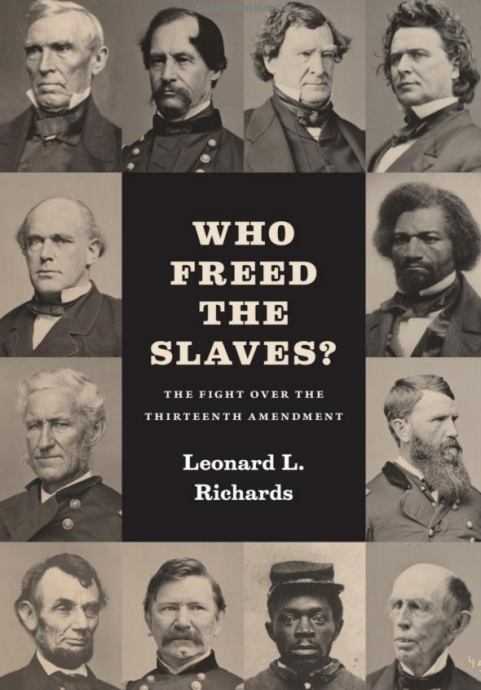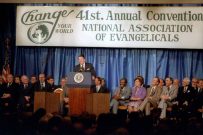Lucky 13
The short answer to the question posed in this book’s title is the Thirteenth Amendment to the Constitution, whose early and chief congressional proponent was Ohio Republican James Mitchell Ashley (1824-1896), a Representative from the district around Toledo. This readable book, published on the sesquicentennial of the amendment’s adoption, spurs us to know more about this remarkable American as well as the other liberators—the antislavery politicians and other public figures, and members of the Union Army, from freedmen soldiers in the ranks to generals. It also depicts their opponents, especially the Democratic Party factions and Kentuckians, and their concerns, both spurious and legitimate.
Even while beginning with Ashley, Who Freed the Slaves? The Fight Over the Thirteenth Amendment might have fleshed out this undeservedly obscure American even more. As a teenager, he worked in the Underground Railroad. He became a journalist and active abolitionist, even accompanying John Brown’s wife to her husband’s execution. In a remarkable address on the House floor in May of 1860, Ashley denounced the “success of the Calhoun revolution,” which had in effect deposed Jefferson as the guiding spirit of the Democratic Party. The new proslavery mentality controlled the federal judiciary, from the district level to the Supreme Court. Through their rulings, the slave-power judges distorted the separation of powers and transformed the United States into a judicial oligarchy that was “incompatible with the first principles of natural right,” in the words of John Quincy Adams, whom Leonard L. Richards mentions a few times in this account (and whose post-White House service in the House of Representatives, lasting 17 years, was a relentless legislative campaign against slavery).
Thus, the Southern charge of dictator against Lincoln neglects the real regime change that had been occurring since the Founding. The full meaning of the antislavery Thirteenth Amendment must be understood against this backdrop—and, I would add, other antislavery authors such as Lysander Spooner, surely read by Representative Ashley but neglected here. Richards’ most glaring omission in this respect is the role of the Declaration of Independence, the document around which the abolitionist forces and the non-abolitionist Abraham Lincoln rallied.
Understood thus, the amendment’s simple wording—
Section 1. Neither slavery nor involuntary servitude, except as a punishment for crime whereof the party shall have been duly convicted, shall exist within the United States, or any place subject to their jurisdiction.
Section 2. Congress shall have power to enforce this article by appropriate legislation.
—conceals revolutionary intentions, namely a restoration of the original Constitution as the fulfillment of the Declaration.
Ashley, who chaired the House Committee on Territories, and whose counterpart chairman in the Democratic-controlled Senate was Stephen Douglas (D-IL), would surely have been familiar with Douglas’ arguments for territories’ right to adopt proslavery state constitutions. And Representative Ashley would also have been familiar with Lincoln’s critique of those arguments.
Pace Richards and the line of scholarship he follows, the restored Constitution, as Ashley argued, would not necessitate court-imposed understandings of individual rights but rather encourage legislation brought about through the consent of the people. The most recent instance of judicial review of national legislation in Dred Scott, as was the case with other rulings of the antebellum era, was not favorable to freedom. The courts not only ruled wrongly but occluded any and every trace of universal liberty that is in the Constitution. It was this judicial domination that brought forth the charge of oligarchy leveled by abolitionists and others.
But how, we might ask, can oligarchy be undone, and the Constitution restored, without recourse to some new (and also constitution-offending) oligarchy? Here Richards is very much up to the job. He skillfully and succinctly presents key elements of the Thirteenth Amendment’s evolution. And despite much skepticism on the part of Richards, Lincoln’s prudence and statesmanship come through, especially when this book addresses the border state that was also the state that clung longest to slavery, Kentucky.
In response to Lincoln’s reported remark, ”I hope to have God on my side, but I must have Kentucky,” abolitionists such as James Russell Lowell complained: “How many times are we to save Kentucky and lose our self respect?” Kentucky’s strategic importance, though, was inarguable. Richards makes clear the political precariousness of its remaining in the Union. In the election of 1860, Lincoln won a mere 1,364 votes in Kentucky, less than 1 percent of the popular vote. But the Constitutional Union Party of Tennessean John Bell won 45 percent of the vote, decisively beating native son John C. Breckinridge, the Democratic Party’s splinter candidate representing the slaveholders (36 percent), and Senator Douglas (18 percent). In 1864, the former Union army commander George McClellan beat his former commander-in-chief by 70 to 30 percent in Kentucky, making it one of the three states he won.
Self-interest and a common culture tied Kentucky to the South. Alexis de Tocqueville’s famous description of the difference between free Ohio, on one bank of the Ohio river, and slave Kentucky on the other, and the drama of Harriet Beecher Stowe’s Uncle Tom’s Cabin testify to the cultural separation of Kentucky from the North. Kentuckians profited from the slave trade (with the third highest earnings from it in the nation). Kentucky politicians bitterly denounced the preliminary Emancipation Proclamation. State regiments split on returning slaves to their owners. As Lincoln had suggested in his eulogy of his beau ideal of a statesman, the Kentuckian Henry Clay, there were limits to how far statesmanship might move self-interested men.
The newly elected Lincoln, in his First Inaugural—which came two weeks after the inauguration of Jefferson Davis as president of the Confederacy—said that to preserve the Union slavery was to be accepted in the states where it existed. In making this concession, he did not follow Lysander Spooner’s (or Frederick Douglass’) judgment that the Constitution was abolitionist. Indeed, Lincoln even declared support for the Corwin Amendment, the 1861 proposed amendment to the Constitution that would have denied Congress the power to abolish slavery. (Though it was passed by Congress and supported by the departing President James Buchanan, it fell well short of ratification in the required three-fourths of the states, and so failed to become what would have been the original Thirteenth Amendment.) And in the midst of war, Lincoln tried repeatedly to urge slave states to pass compensated emancipation laws.
Lincoln recognized that abolition would amount to a destruction or confiscation of wealth. He had difficulty enough getting fearful anti-abolitionist Unionists to accept black soldiers in the Union Army. Some Union generals favored emancipation for practical military reasons, yet only after Jefferson Davis approved the freeing of slaves so they could serve in the Confederate Army did Northern opposition to emancipation crumble. Lincoln made a virtue of this wartime-necessity support, and channeled it into a campaign for passage of the Thirteenth Amendment, noting that Roger Taney, Chief Justice of the Supreme Court, might further expand the Fifth Amendment’s takings clause to protect slavery, even against his Emancipation Proclamation.
Most difficult of all was Lincoln’s effort to protect blacks from racial hatred. Here Richards falters, by playing up Lincoln’s support for colonization. Interpreting Lincoln’s remarks to black ministers, Richards does not see that Lincoln was challenging them to urge their fellow free blacks to continue to live in a country where “our white men [are] cutting one another’s throats” over the “institution of Slavery and the colored race.” He was not ordering them out of the country, but rather was asking, did they love the country enough to stay? Moreover, he did not urge distant Liberia but preferred nearby Central America as a possible location of an American black colony. Though the location proved unsuitable, it afforded a republican alternative to Haiti and the horrors that that country represented (the slave uprising of Toussaint L’Overture) for white Southerners.
But all this lay in the future. In 1861 Lincoln confronted a North where Democrats who were pro-Union but anti-Emancipation held significant political power. The New York anti-draft riots exploded into black lynchings. Every attempt to transform the war from one solely between whites came under fire, from equal pay for black soldiers to trading captive Confederates for black prisoners—those whom the Confederates did not slaughter, along with their white officers. Nor did the Confederacy’s freeing some of its slaves compromise its racial regime identity. The antebellum oligarchy based on slavery would become one based on race. And there was even talk in Congress of re-enslavement.
Against this backdrop, we see not only the terrifying picture that Lincoln would so memorably evoke in his Second Inaugural, but also the practical difficulties faced by Representative Ashley, Lincoln, and others to gain a two-thirds majority for the Thirteenth Amendment in the House of Representatives. With the Southern states no longer represented in the U.S. Congress, the Senate readily voted in favor. The Radical Republicans in the Senate had to compromise by deleting language explicitly guaranteeing the universal freedom that Ashley and others wanted to see affirmed.
Amendment proponents appeared to face an insuperable obstacle to obtaining 11 additional votes in the House. But the Republicans exploited the opportunities presented by a quirk in the congressional calendar which, writes Richards, dictated that “in every even-numbered year congress would be literally half-full of lame ducks.” Members who had been elected in 1864 would not be sworn in until December, 1865. And there was a great deal of turnover as well. These conditions supplied Lincoln an opening for the canny operatives we saw at work in the 2012 movie Lincoln. Richards accepts the disputed view of Radical Republican Representative Thaddeus Stevens (R-PA) that the “greatest measure of the nineteenth century” had been “passed by corruption . . . aided and abetted” by Lincoln.
Unfortunately, Richards doesn’t draw out the most important lessons of the Thirteenth Amendment for our time. It appears he even favors mischievous interpretations, such as seeing in it a constitutional imperative against income inequality. But his arguments—they are in the same vein as the more detailed work by James Oakes, Freedom National (2013)—indicate that other, more robustly republican interpretations remain alive.
The antislavery cause was not only about abolishing individual ownership of individual slaves but about eliminating the political power and legitimacy of the slaveholding class. In restoring the original Constitution, one suffused with the Declaration of Independence, the Thirteenth Amendment is (or should be) the final word. To secure justice, no further amendments to a republican constitution are needed. Other relevant clauses in the Founding charter can all now do their originally intended work (as I have written previously at Law and Liberty here and here).
It is imperative when studying these issues, as Michael Les Benedict has argued (A Compromise of Principle, 1974), to recover the perspective of the amendment’s framers. They “did not conceive that the courts would be the primary agency that would enforce it,” wrote Benedict. “They expected it to be enforced through the political process”—that is, enforced by the principle of the consent of the governed. Otherwise, this amendment adopted in 1865 might become a means of enslaving freemen in the guise of emancipating slaves. (The young Lincoln, in his Lyceum Address of 1838, had warned of such perverse uses of the noblest of causes.)
The greatest blessing of celebrating the sesquicentennial of the Thirteenth Amendment would be realizing that, in the battle between slavery and freedom, perhaps the leading issue is reviving constitutional government by returning it to the people and their elected representatives, and wresting it from legal elites.


